1. Agrawal M, Shah S, Patel A, Pinotti R, Colombel JF, Burisch J. Changing epidemiology of immune-mediated inflammatory diseases in immigrants: a systematic review of population-based studies. J Autoimmun. 2019; 105:102303. PMID:
31351784.

2. El-Gabalawy H, Guenther LC, Bernstein CN. Epidemiology of immune-mediated inflammatory diseases: incidence, prevalence, natural history, and comorbidities. J Rheumatol Suppl. 2010; 85(0):2–10. PMID:
20436161.

3. Hanauer SB. Inflammatory bowel disease: epidemiology, pathogenesis, and therapeutic opportunities. Inflamm Bowel Dis. 2006; 12(Suppl 1):S3–S9. PMID:
16378007.

4. Littlejohn EA. Pregnancy and rheumatoid arthritis. Best Pract Res Clin Obstet Gynaecol. 2020; 64:52–58. PMID:
31672290.

5. Barenbrug L, Groen MT, Hoentjen F, van Drongelen J, Reek JM, Joosten I, et al. Pregnancy and neonatal outcomes in women with immune mediated inflammatory diseases exposed to anti-tumor necrosis factor-α during pregnancy: a systemic review and meta-analysis. J Autoimmun. 2021; 122:102676. PMID:
34126302.

6. Kim H, Sung YK. Epidemiology of rheumatoid arthritis in Korea. J Rheum Dis. 2021; 28(2):60–67.

7. Palomba S, Sereni G, Falbo A, Beltrami M, Lombardini S, Boni MC, et al. Inflammatory bowel diseases and human reproduction: a comprehensive evidence-based review. World J Gastroenterol. 2014; 20(23):7123–7136. PMID:
24966584.

8. Tincani A, Taylor P, Fischer-Betz R, Ecoffet C, Chakravarty E. FRI0693 Fears and misconceptions of women with chronic rheumatic diseases on their journey to motherhood. Ann Rheum Dis. 2018; 77(Suppl 2):866.
9. Allen KD, Kiefer MK, Butnariu M, Afzali A. Pregnant women with immune mediated inflammatory diseases who discontinue biologics have higher rates of disease flare. Arch Gynecol Obstet. 2022; 306(6):1929–1937. PMID:
35249153.

10. Ghalandari N, Dolhain RJ, Hazes JM, van Puijenbroek EP, Kapur M, Crijns HJ. Intrauterine exposure to biologics in inflammatory autoimmune diseases: a systematic review. Drugs. 2020; 80(16):1699–1722. PMID:
32852745.

11. Baker KF, Isaacs JD. Novel therapies for immune-mediated inflammatory diseases: What can we learn from their use in rheumatoid arthritis, spondyloarthritis, systemic lupus erythematosus, psoriasis, Crohn’s disease and ulcerative colitis? Ann Rheum Dis. 2018; 77(2):175–187. PMID:
28765121.

12. Kuek A, Hazleman BL, Ostör AJ. Immune-mediated inflammatory diseases (IMIDs) and biologic therapy: a medical revolution. Postgrad Med J. 2007; 83(978):251–260. PMID:
17403952.

13. Kim J, Koh JH, Choi SJ, Jeon CH, Kwok SK, Kim SK, et al. KOBIO, the first web-based Korean biologics registry operated with a unified platform among distinct disease entities. J Rheum Dis. 2021; 28(4):176–182.

14. Nguyen GC, Seow CH, Maxwell C, Huang V, Leung Y, Jones J, et al. The Toronto consensus statements for the management of inflammatory bowel disease in pregnancy. Gastroenterology. 2016; 150(3):734–757.e1. PMID:
26688268.

15. Mahadevan U, Robinson C, Bernasko N, Boland B, Chambers C, Dubinsky M, et al. Inflammatory bowel disease in pregnancy clinical care pathway: a report from the American Gastroenterological Association IBD Parenthood Project Working Group. Gastroenterology. 2019; 156(5):1508–1524. PMID:
30658060.

16. Sammaritano LR, Bermas BL, Chakravarty EE, Chambers C, Clowse ME, Lockshin MD, et al. 2020 American College of Rheumatology guideline for the management of reproductive health in rheumatic and musculoskeletal diseases. Arthritis Rheumatol. 2020; 72(4):529–556. PMID:
32090480.

17. Park JS, Lee CH. Clinical study using healthcare claims database. J Rheum Dis. 2021; 28(3):119–125.

18. Kim HO, Lee K, Lee SM, Seo GH. Association between pregnancy outcomes and radioactive iodine treatment after thyroidectomy among women with thyroid cancer. JAMA Intern Med. 2020; 180(1):54–61. PMID:
31633736.

19. Charlson ME, Pompei P, Ales KL, MacKenzie CR. A new method of classifying prognostic comorbidity in longitudinal studies: development and validation. J Chronic Dis. 1987; 40(5):373–383. PMID:
3558716.

20. Quan H, Sundararajan V, Halfon P, Fong A, Burnand B, Luthi JC, et al. Coding algorithms for defining comorbidities in ICD-9-CM and ICD-10 administrative data. Med Care. 2005; 43(11):1130–1139. PMID:
16224307.

21. Singh JA, Saag KG, Bridges SL Jr, Akl EA, Bannuru RR, Sullivan MC, et al. 2015 American College of Rheumatology guideline for the treatment of rheumatoid arthritis. Arthritis Rheumatol. 2016; 68(1):1–26.

22. Tsao NW, Lynd LD, Sadatsafavi M, Hanley G, De Vera MA. Patterns of biologics utilization and discontinuation before and during pregnancy in women with autoimmune diseases: a population-based cohort study. Arthritis Care Res (Hoboken). 2018; 70(7):979–986. PMID:
28973840.

23. Lee HH, Bae JM, Lee BI, Lee KM, Wie JH, Kim JS, et al. Pregnancy outcomes in women with inflammatory bowel disease: a 10-year nationwide population-based cohort study. Aliment Pharmacol Ther. 2020; 51(9):861–869. PMID:
32266739.

24. Lee JS, Oh JS, Kim YJ, Hong S, Lee CK, Yoo B, et al. Effects of pregnancy and delivery methods on change in ankylosing spondylitis treatment using the Korean health insurance review and assessment service claims database. J Korean Med Sci. 2019; 34(37):e238. PMID:
31559710.

25. Baumgart DC, Misery L, Naeyaert S, Taylor PC. Biological therapies in immune-mediated inflammatory diseases: can biosimilars reduce access inequities? Front Pharmacol. 2019; 10:279. PMID:
30983996.

26. Park EH, Lee JS, Kim YJ, Lee SM, Jun JK, Lee EB, et al. Pregnancy outcomes in Korean women with ankylosing spondylitis. Korean J Intern Med. 2021; 36(3):721–730. PMID:
31556255.

27. Bartha JL, Romero-Carmona R, Comino-Delgado R. Inflammatory cytokines in intrauterine growth retardation. Acta Obstet Gynecol Scand. 2003; 82(12):1099–1102. PMID:
14616253.

28. Bröms G, Kieler H, Ekbom A, Gissler M, Hellgren K, Lahesmaa-Korpinen AM, et al. Anti-TNF treatment during pregnancy and birth outcomes: A population-based study from Denmark, Finland, and Sweden. Pharmacoepidemiol Drug Saf. 2020; 29(3):316–327. PMID:
32020767.

29. Mirdamadi K, Salinas T, Vali R, Papadimitropoulos M, Piquette-Miller M. Meta-analysis of pregnancy outcomes after exposure to TNF-α inhibitors during pregnancy for the treatment of arthritic diseases. J Popul Ther Clin Pharmacol. 2018; 25(1):e53–e56. PMID:
29949681.
30. Kim AM, Park JH, Kang S, Yoon TH, Kim Y. An ecological study of geographic variation and factors associated with cesarean section rates in South Korea. BMC Pregnancy Childbirth. 2019; 19(1):162. PMID:
31072318.

31. Shand AW, Chen JS, Selby W, Solomon M, Roberts CL. Inflammatory bowel disease in pregnancy: a population-based study of prevalence and pregnancy outcomes. BJOG. 2016; 123(11):1862–1870. PMID:
26924786.

32. Wallenius M, Skomsvoll JF, Irgens LM, Salvesen KA, Nordvåg BY, Koldingsnes W, et al. Pregnancy and delivery in women with chronic inflammatory arthritides with a specific focus on first birth. Arthritis Rheum. 2011; 63(6):1534–1542. PMID:
21630243.

33. Lee JS, Oh JS, Kim YJ, Hong S, Lee CK, Yoo B, et al. Reasons for the high cesarean delivery rate among women with ankylosing spondylitis: using the Korean National Health Insurance database. J Rheumatol. 2020; 47(5):668–673. PMID:
31615913.

34. Skomsvoll JF, Ostensen M, Irgens LM, Baste V. Pregnancy complications and delivery practice in women with connective tissue disease and inflammatory rheumatic disease in Norway. Acta Obstet Gynecol Scand. 2000; 79(6):490–495. PMID:
10857874.

35. Dessein PH, Joffe BI. Insulin resistance and impaired beta cell function in rheumatoid arthritis. Arthritis Rheum. 2006; 54(9):2765–2775. PMID:
16947779.

36. Paschou SA, Kothonas F, Lafkas A, Myroforidis A, Loi V, Terzi T, et al. Favorable effect of anti-TNF therapy on insulin sensitivity in nonobese, nondiabetic patients with inflammatory bowel disease. Int J Endocrinol. 2018; 2018:6712901. PMID:
29576769.

37. Nam SH, Kim M, Kim YJ, Ahn SM, Hong S, Lee CK, et al. Risk of new-onset diabetes mellitus associated with antirheumatic drugs in patients with rheumatoid arthritis: a nationwide population study. J Clin Med. 2022; 11(8):2109. PMID:
35456202.

38. Baker JF, England BR, George M, Cannon G, Sauer B, Ogdie A, et al. Disease activity, cytokines, chemokines and the risk of incident diabetes in rheumatoid arthritis. Ann Rheum Dis. 2021; 80(5):566–572. PMID:
33397733.

39. Antohe JL, Bili A, Sartorius JA, Kirchner HL, Morris SJ, Dancea S, et al. Diabetes mellitus risk in rheumatoid arthritis: reduced incidence with anti-tumor necrosis factor α therapy. Arthritis Care Res (Hoboken). 2012; 64(2):215–221. PMID:
21972198.

40. Lin C, Ji H, Cai X, Yang W, Lv F, Ji L. The association between the biological disease-modifying anti-rheumatic drugs and the incidence of diabetes: a systematic review and meta-analysis. Pharmacol Res. 2020; 161:105216. PMID:
33007415.

41. Pantham P, Aye IL, Powell TL. Inflammation in maternal obesity and gestational diabetes mellitus. Placenta. 2015; 36(7):709–715. PMID:
25972077.

42. Hunt JS, Chen HL, Miller L. Tumor necrosis factors: pivotal components of pregnancy? Biol Reprod. 1996; 54(3):554–562. PMID:
8835376.
43. Romanowska-Próchnicka K, Felis-Giemza A, Olesińska M, Wojdasiewicz P, Paradowska-Gorycka A, Szukiewicz D. The role of TNF-α and anti-TNF-α agents during preconception, pregnancy, and breastfeeding. Int J Mol Sci. 2021; 22(6):2922. PMID:
33805757.

44. Alijotas-Reig J, Esteve-Valverde E, Ferrer-Oliveras R, Llurba E, Gris JM. Tumor necrosis factor-alpha and pregnancy: focus on biologics. an updated and comprehensive review. Clin Rev Allergy Immunol. 2017; 53(1):40–53. PMID:
28054230.

45. Katz JA, Antoni C, Keenan GF, Smith DE, Jacobs SJ, Lichtenstein GR. Outcome of pregnancy in women receiving infliximab for the treatment of Crohn’s disease and rheumatoid arthritis. Am J Gastroenterol. 2004; 99(12):2385–2392. PMID:
15571587.

46. O’Byrne LJ, Alqatari SG, Maher GM, O’Sullivan AM, Khashan AS, Murphy GP, et al. Fetal and maternal outcomes after maternal biologic use during conception and pregnancy: a systematic review and meta-analysis. BJOG. 2022; 129(8):1236–1246. PMID:
35014759.

47. Lee KE, Jung SA, Park SH, Moon CM, Shim SY, Kim ES, et al. Influence of anti-tumor necrosis factor-alpha therapy to pregnant inflammatory bowel disease women and their children’s immunity. Intest Res. 2019; 17(2):237–243. PMID:
30727711.

48. Agret F, Cosnes J, Hassani Z, Gornet JM, Gendre JP, Lémann M, et al. Impact of pregnancy on the clinical activity of Crohn’s disease. Aliment Pharmacol Ther. 2005; 21(5):509–513. PMID:
15740532.

49. Hazes JM, Coulie PG, Geenen V, Vermeire S, Carbonnel F, Louis E, et al. Rheumatoid arthritis and pregnancy: evolution of disease activity and pathophysiological considerations for drug use. Rheumatology (Oxford). 2011; 50(11):1955–1968. PMID:
21890617.

50. Andreoli L, García-Fernández A, Chiara Gerardi M, Tincani A. The course of rheumatic diseases during pregnancy. Isr Med Assoc J. 2019; 21(7):464–470. PMID:
31507122.
51. Restellini S, Biedermann L, Hruz P, Mottet C, Moens A, Ferrante M, et al. Update on the management of inflammatory bowel disease during pregnancy and breastfeeding. Digestion. 2020; 101(Suppl 1):27–42. PMID:
31914444.

52. Komaki F, Komaki Y, Micic D, Ido A, Sakuraba A. Outcome of pregnancy and neonatal complications with anti-tumor necrosis factor-α use in females with immune mediated diseases; a systematic review and meta-analysis. J Autoimmun. 2017; 76:38–52. PMID:
27913060.

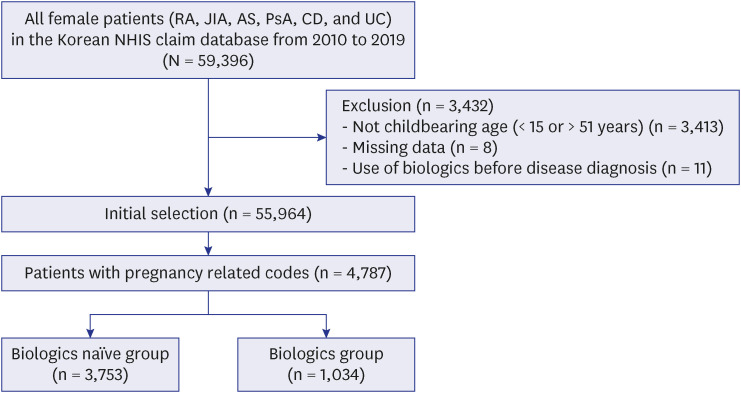
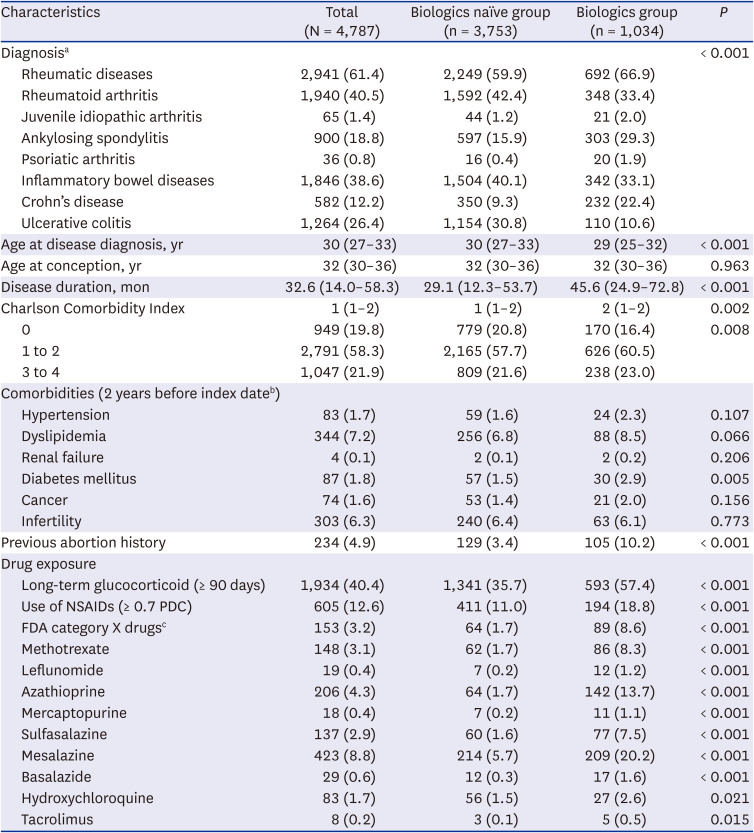
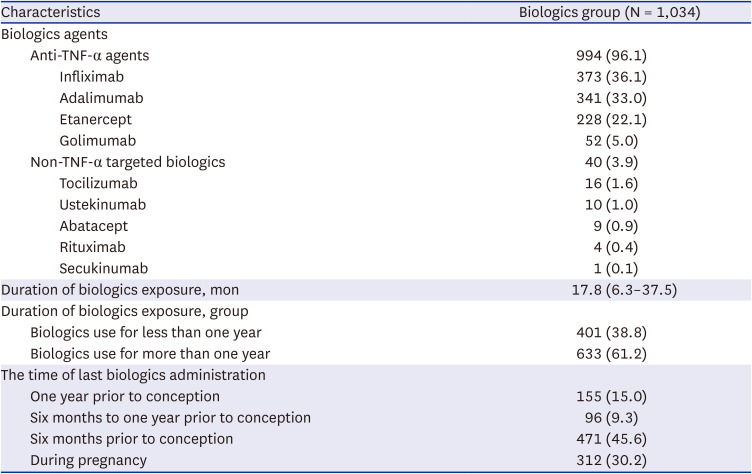
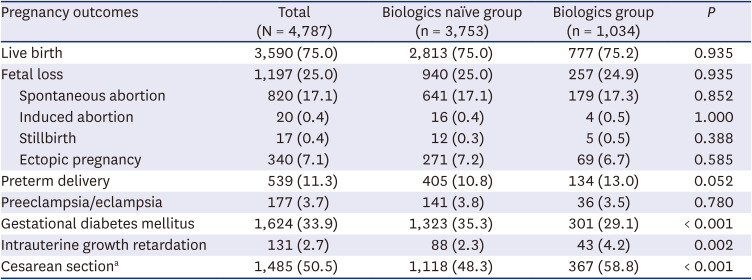
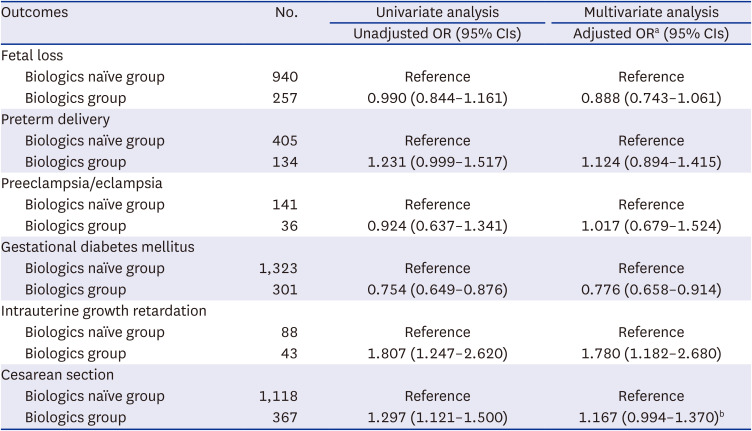
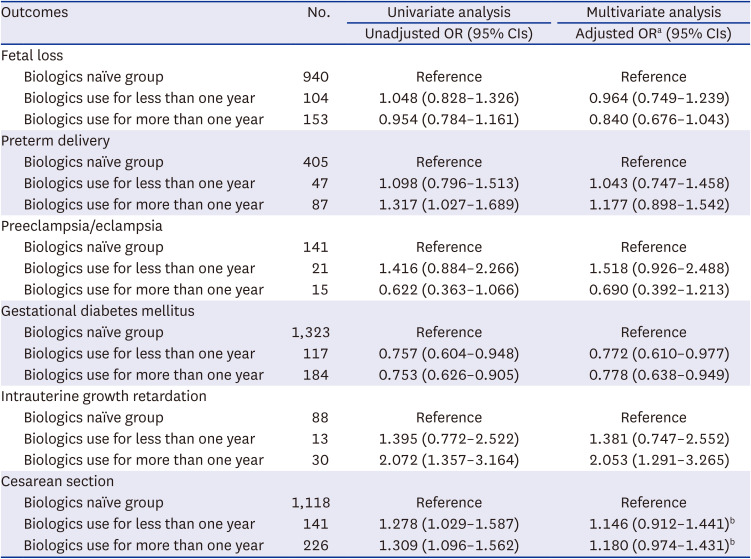
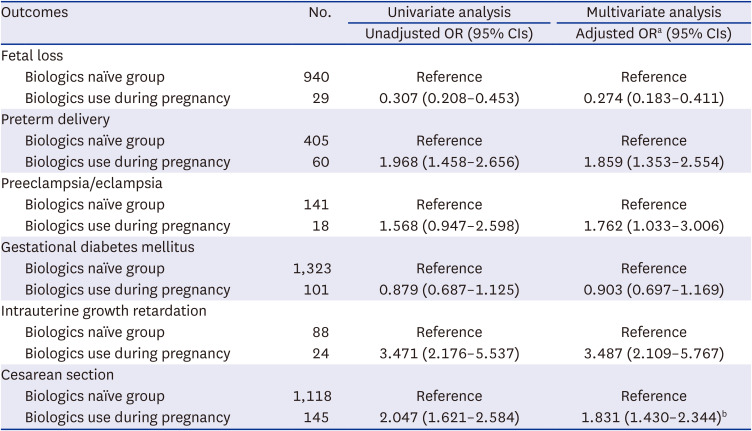




 PDF
PDF Citation
Citation Print
Print



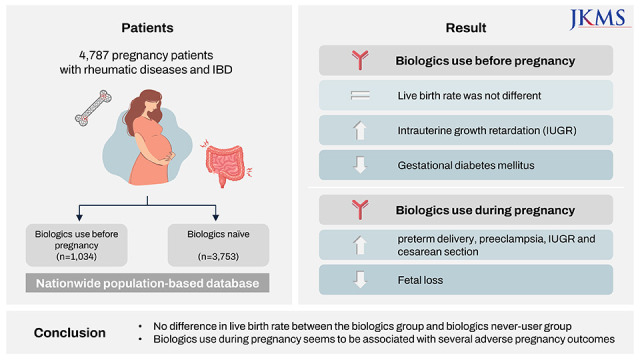
 XML Download
XML Download